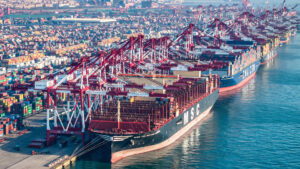The Global Trade Forecast: Navigating the Tempestuous Waters of Tariffs
Welcome to the Extreme Investor Network blog, where we bring you the most insightful analysis on economic trends influencing your investments. Today, we delve into a key concern impacting global trade dynamics: the recently heightened tariff environment, particularly under the Trump administration, and its implications for worldwide commerce moving forward.
A Sharp Turn: Evaluating the Current Trade Landscape
As we step into 2025, the World Trade Organization (WTO) has issued a cautious warning regarding the future of global trade. In its latest report, the organization outlines a troubling projection: global merchandise trade is anticipated to decline by 0.2% this year, following a robust growth of 2.9% in 2024. As experts in economic trends, we at Extreme Investor Network see this decline as a pivotal moment, highlighting how quickly the landscape can change due to trade policies and tariffs.
Recent developments in the tariff regime, particularly those initiated by President Trump, have significantly shifted the trade balance. Notably, the resurgence of tariffs has generated a sense of uncertainty among traders, causing a ripple effect across markets. For instance, predictions indicate that the United States could experience a sharp 12.6% drop in exports this year alone.
The Tariff Tango: U.S.-China Relations in Fracture
At the heart of these trade tensions is the U.S.-China relationship. In April 2025, Trump startled the global community with a sweeping array of reciprocal tariffs affecting over 180 countries—an act that substantially increased duties on Chinese imports to a staggering 145%. China’s swift counteraction, imposing tariffs up to 125% on U.S. imports, has led experts like Ralph Ossa, chief economist at the WTO, to predict a "drastic contraction" in bilateral trade.
What does this mean for investors and businesses alike? As international markets react to these policy shifts, the focus turns to trade diversion—an often-overlooked consequence of tariffs that presents both challenges and opportunities. The disruption in U.S.-China commerce is expected to redirect trade pathways, potentially benefiting third-party nations that can fill the supply gaps.
Unpacking the Stats: Understanding the Numbers
The WTO’s analysis brings to light essential figures:
- A projected 1.7 percentage point reduction in global merchandise trade growth for 2025 due to North America’s new tariffs.
- A concerning 0.6 percentage point contribution from Asia—down from previous estimates.
- The anticipated rise in Chinese merchandise exports by 4% to 9% to markets outside North America, notably impacting textile, apparel, and electrical equipment sectors as U.S. imports decrease.
For least-developed countries (LDCs), this shifting trade landscape offers a glimmer of hope as they seek to capture new export opportunities arising from gaps left by conventional suppliers.
The Ripple Effect: Why Region Matters
As we analyze these changes, it’s imperative to remember that the effects of tariffs and trade policies vary significantly by region. In the Americas, we see a pronounced decline, while nations in Asia and Europe are offered a lukewarm opportunity to adjust and benefit from redirection in trade. However, these regions also face new challenges, such as competition from redirected Chinese exports and adjusted market dynamics.
This leads us to a crucial question for investors: How can one leverage these shifts? Understanding the nature of trade flows can help you identify emerging markets and sectors ready to capitalize on the evolving landscape. For example, as tariffs reshape the marketplace, industries providing alternative suppliers or logistical solutions will become increasingly valuable.
Navigating Forward: What Lies Ahead
While the WTO’s forecast indicates severe downside risks, including the potential for additional tariff implementation leading to a 1.5% decline in global trade volume, it’s essential to be aware of the competitive dynamics that underpin these figures. Countries across Asia, Europe, and even LDCs are gearing up to adapt and find new pathways for trade.
The Extreme Investor Network remains committed to providing you with the insights you need to navigate these turbulent waters. As global dynamics continue to shift, staying informed and agile can give you the upper hand in your financial endeavors. Be sure to check back regularly for updates and in-depth analysis on the impact of tariffs and global trade trends on your investments.
Together, we will weather the storms of change and emerge stronger in the world of investment.

